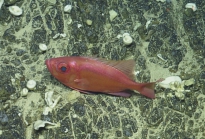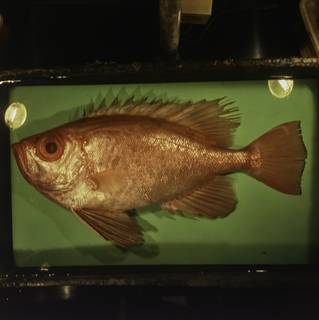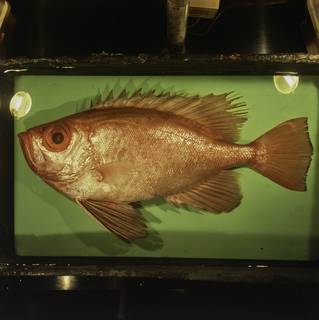WoRMS taxon details
Cookeolus japonicus (Cuvier, 1829)
127003 (urn:lsid:marinespecies.org:taxname:127003)
accepted
Species
Priacanthus alticlarens Valenciennes, 1862 · unaccepted
Priacanthus japonicus Cuvier, 1829 · unaccepted
Priacanthus macropterus Valenciennes, 1831 · unaccepted
Priacanthus macropus Valenciennes, 1831 · unaccepted
Priacanthus supraarmatus Hilgendorf, 1879 · unaccepted
Priacanthus velabundus McCulloch, 1915 · unaccepted
marine, brackish, fresh, terrestrial
(of Priacanthus japonicus Cuvier, 1829) Cuvier, G.; Valenciennes, A. (1829). Histoire naturelle des poissons. Tome troisième. Suite du Livre troisième. Des percoïdes à dorsale unique à sept rayons branchiaux et à dents en velours ou en cardes. <em>F. G. Levrault, Paris.</em> v. 3: i-xxviii + 2 pp. + 1-500, Pls. 41-71. [Cuvier authored volume. i-xxii + 1-368 in Strasbourg edition.].
page(s): 106, Pl. 50 [details]
page(s): 106, Pl. 50 [details]
Description Found on hard bottoms to a depth ofabout 400 m and reported to be moderately common at depths of 165 to 260 m in...
Distribution Western Atlantic: New Jersey, North Carolina, USA to probably Argentina; southern Caribbean and southern Brazil
Description Found on hard bottoms to a depth ofabout 400 m and reported to be moderately common at depths of 165 to 260 m in association with rocky holes and ledges. Juveniles are pelagic (Refs. 9335; 9563). Reported to feed on pelagic crabs. Probably spawns in the Caribbean from May to September. [details]
Distribution Western Atlantic: New Jersey, North Carolina, USA to probably Argentina; southern Caribbean and southern Brazil
Distribution Western Atlantic: New Jersey, North Carolina, USA to probably Argentina; southern Caribbean and southern Brazil [details]
Froese, R. and D. Pauly. Editors. (2025). FishBase. Cookeolus japonicus (Cuvier, 1829). Accessed through: World Register of Marine Species at: https://www.marinespecies.org/aphia.php?p=taxdetails&id=127003 on 2025-04-01
Date
action
by
![]() The webpage text is licensed under a Creative Commons
Attribution-Noncommercial 4.0 License
The webpage text is licensed under a Creative Commons
Attribution-Noncommercial 4.0 License
Nomenclature
original description
(of Priacanthus alticlarens Valenciennes, 1862) Valenciennes, A. (1862). Description de quelques espèces nouvelles de poissons envoyées de Bourbon par M. Morel, directeur du Muséum d'Histoire naturelle de cette île. <em>Comptes Rendus Hebdomadaires des Séances de l'Académie des Sciences.</em> v. 54: 1165-1170; (suite) 1201-1207. [details]
original description (of Priacanthus japonicus Cuvier, 1829) Cuvier, G.; Valenciennes, A. (1829). Histoire naturelle des poissons. Tome troisième. Suite du Livre troisième. Des percoïdes à dorsale unique à sept rayons branchiaux et à dents en velours ou en cardes. <em>F. G. Levrault, Paris.</em> v. 3: i-xxviii + 2 pp. + 1-500, Pls. 41-71. [Cuvier authored volume. i-xxii + 1-368 in Strasbourg edition.].
page(s): 106, Pl. 50 [details]
original description (of Priacanthus macropterus Valenciennes, 1831) Cuvier, G.; Valenciennes, A. (1831). Histoire naturelle des poissons. Tome septième. Livre septième. Des Squamipennes. Livre huitième. Des poissons à pharyngiens labyrinthiformes. <em>F. G. Levrault, Paris.</em> v. 7: i-xxix + 1-531, Pls. 170-208. [Cuvier authored pp. 1-440, Valenciennes 441-531. i-xxii + 1-399 in Strasbourg edition.]. [details]
original description (of Priacanthus macropus Valenciennes, 1831) Cuvier, G.; Valenciennes, A. (1831). Histoire naturelle des poissons. Tome septième. Livre septième. Des Squamipennes. Livre huitième. Des poissons à pharyngiens labyrinthiformes. <em>F. G. Levrault, Paris.</em> v. 7: i-xxix + 1-531, Pls. 170-208. [Cuvier authored pp. 1-440, Valenciennes 441-531. i-xxii + 1-399 in Strasbourg edition.]. [details]
basis of record van der Land, J.; Costello, M.J.; Zavodnik, D.; Santos, R.S.; Porteiro, F.M.; Bailly, N.; Eschmeyer, W.N.; Froese, R. (2001). Pisces, <B><I>in</I></B>: Costello, M.J. <i>et al.</i> (Ed.) (2001). <i>European register of marine species: a check-list of the marine species in Europe and a bibliography of guides to their identification. Collection Patrimoines Naturels,</i> 50: pp. 357-374 (look up in IMIS) [details]
original description (of Priacanthus japonicus Cuvier, 1829) Cuvier, G.; Valenciennes, A. (1829). Histoire naturelle des poissons. Tome troisième. Suite du Livre troisième. Des percoïdes à dorsale unique à sept rayons branchiaux et à dents en velours ou en cardes. <em>F. G. Levrault, Paris.</em> v. 3: i-xxviii + 2 pp. + 1-500, Pls. 41-71. [Cuvier authored volume. i-xxii + 1-368 in Strasbourg edition.].
page(s): 106, Pl. 50 [details]
original description (of Priacanthus macropterus Valenciennes, 1831) Cuvier, G.; Valenciennes, A. (1831). Histoire naturelle des poissons. Tome septième. Livre septième. Des Squamipennes. Livre huitième. Des poissons à pharyngiens labyrinthiformes. <em>F. G. Levrault, Paris.</em> v. 7: i-xxix + 1-531, Pls. 170-208. [Cuvier authored pp. 1-440, Valenciennes 441-531. i-xxii + 1-399 in Strasbourg edition.]. [details]
original description (of Priacanthus macropus Valenciennes, 1831) Cuvier, G.; Valenciennes, A. (1831). Histoire naturelle des poissons. Tome septième. Livre septième. Des Squamipennes. Livre huitième. Des poissons à pharyngiens labyrinthiformes. <em>F. G. Levrault, Paris.</em> v. 7: i-xxix + 1-531, Pls. 170-208. [Cuvier authored pp. 1-440, Valenciennes 441-531. i-xxii + 1-399 in Strasbourg edition.]. [details]
basis of record van der Land, J.; Costello, M.J.; Zavodnik, D.; Santos, R.S.; Porteiro, F.M.; Bailly, N.; Eschmeyer, W.N.; Froese, R. (2001). Pisces, <B><I>in</I></B>: Costello, M.J. <i>et al.</i> (Ed.) (2001). <i>European register of marine species: a check-list of the marine species in Europe and a bibliography of guides to their identification. Collection Patrimoines Naturels,</i> 50: pp. 357-374 (look up in IMIS) [details]
Ecology
ecology source
Looby, A.; Erbe, C.; Bravo, S.; Cox, K.; Davies, H. L.; Di Iorio, L.; Jézéquel, Y.; Juanes, F.; Martin, C. W.; Mooney, T. A.; Radford, C.; Reynolds, L. K.; Rice, A. N.; Riera, A.; Rountree, R.; Spriel, B.; Stanley, J.; Vela, S.; Parsons, M. J. G. (2023). Global inventory of species categorized by known underwater sonifery. <em>Scientific Data.</em> 10(1). (look up in IMIS), available online at https://doi.org/10.1038/s41597-023-02745-4 [details] 
Other
context source (Deepsea)
Intergovernmental Oceanographic Commission (IOC) of UNESCO. The Ocean Biogeographic Information System (OBIS), available online at http://www.iobis.org/ [details]
context source (HKRMS) Hong Kong marine fish database. <em>AFCD.</em> , available online at https://www.hk-fish.net/en/fish/introduction/ [details]
context source (Bermuda) Smith-Vaniz, W. F.; Collette, B. B.; Luckhurst, B. E (1999). Fishes of Bermuda: History, zoogeography, annotated checklist, and identification keys (American Society of Ichthyologists and Herpetologists - Special Publication No.4) . ASIH, 424 pp. [details]
context source (PeRMS) Chirichigno, N.; Cornejo, M. (2001). Catálogo comentado de los peces marinos del Perú. <em>2ª ed. Instituto del Mar de Perú. Publicación Especial. Callao.</em> 314 p. [details]
additional source Liu, J.Y. [Ruiyu] (ed.). (2008). Checklist of marine biota of China seas. <em>China Science Press.</em> 1267 pp. (look up in IMIS) [details] Available for editors [request]
[request]
additional source Froese, R. & D. Pauly (Editors). (2025). FishBase. World Wide Web electronic publication. version (06/2024)., available online at https://www.fishbase.org [details]
context source (HKRMS) Hong Kong marine fish database. <em>AFCD.</em> , available online at https://www.hk-fish.net/en/fish/introduction/ [details]
context source (Bermuda) Smith-Vaniz, W. F.; Collette, B. B.; Luckhurst, B. E (1999). Fishes of Bermuda: History, zoogeography, annotated checklist, and identification keys (American Society of Ichthyologists and Herpetologists - Special Publication No.4) . ASIH, 424 pp. [details]
context source (PeRMS) Chirichigno, N.; Cornejo, M. (2001). Catálogo comentado de los peces marinos del Perú. <em>2ª ed. Instituto del Mar de Perú. Publicación Especial. Callao.</em> 314 p. [details]
additional source Liu, J.Y. [Ruiyu] (ed.). (2008). Checklist of marine biota of China seas. <em>China Science Press.</em> 1267 pp. (look up in IMIS) [details] Available for editors
additional source Froese, R. & D. Pauly (Editors). (2025). FishBase. World Wide Web electronic publication. version (06/2024)., available online at https://www.fishbase.org [details]
 Present
Present  Present in aphia/obis/gbif/idigbio
Present in aphia/obis/gbif/idigbio  Inaccurate
Inaccurate  Introduced: alien
Introduced: alien  Containing type locality
Containing type locality
Unreviewed
Description Found on hard bottoms to a depth ofabout 400 m and reported to be moderately common at depths of 165 to 260 m in association with rocky holes and ledges. Juveniles are pelagic (Refs. 9335; 9563). Reported to feed on pelagic crabs. Probably spawns in the Caribbean from May to September. [details]Diet Feeds on pelagic crustaceans [details]
Distribution Western Atlantic: New Jersey, North Carolina, USA to probably Argentina; southern Caribbean and southern Brazil [details]
Habitat Found on hard bottoms to a depth of about 400 m and reported to be moderately common at depths of 165 to 260 m in association with rocky holes and ledges. [details]
Habitat nektonic [details]
Habitat Known from seamounts and knolls [details]
Importance Social- Commercial fishery [details]
Reproduction Probably spawns in the Caribbean from May to September. [details]
| Language | Name | |
|---|---|---|
| English | longfinned bullseyebulleye | [details] |
| Japanese | チカメキントキ | [details] |
| Russian | Каталуф (кукеолус) японский | [details] |
| Spanish | catalufa aleta larga | [details] |
To Barcode of Life (48 barcodes)
To Biodiversity Heritage Library (1 publication)
To Biodiversity Heritage Library (2 publications) (from synonym Priacanthus velabundus McCulloch, 1915)
To Biodiversity Heritage Library (29 publications) (from synonym Priacanthus japonicus Cuvier, 1829)
To Biodiversity Heritage Library (3 publications) (from synonym Priacanthus supraarmatus Hilgendorf, 1879)
To Biodiversity Heritage Library (5 publications) (from synonym Priacanthus macropterus Valenciennes, 1831)
To Biodiversity Heritage Library (8 publications) (from synonym Priacanthus macropus Valenciennes, 1831)
To Biodiversity Heritage Library (8 publications) (from synonym Priacanthus alticlarens Valenciennes, 1862)
To Biological Information System for Marine Life (BISMaL) (from synonym Priacanthus japonicus Cuvier, 1829)
To Biological Information System for Marine Life (BISMaL)
To European Nucleotide Archive, ENA (Cookeolus japonicus)
To FishBase (from synonym Priacanthus japonicus Cuvier, 1829)
To FishBase (from synonym Priacanthus alticlarens Valenciennes, 1862)
To FishBase (from synonym Priacanthus macropterus Valenciennes, 1831)
To FishBase
To FishBase (from synonym Priacanthus supraarmatus Hilgendorf, 1879)
To FishBase (from synonym Priacanthus macropus Valenciennes, 1831)
To FishBase (from synonym Priacanthus velabundus McCulloch, 1915)
To FishBase images (Cookeolus japonicus, Indonesia, by Steene, R.)
To GenBank (57 nucleotides; 64 proteins)
To GenBank (57 nucleotides; 64 proteins) (from synonym Priacanthus japonicus Cuvier, 1829)
To Global Biotic Interactions (GloBI)
To IUCN Red List (Least Concern)
To NMNH Extant Collection (Cookeolus japonicus FIN032676 Slide 120 mm)
To PESI
To ITIS
To Biodiversity Heritage Library (1 publication)
To Biodiversity Heritage Library (2 publications) (from synonym Priacanthus velabundus McCulloch, 1915)
To Biodiversity Heritage Library (29 publications) (from synonym Priacanthus japonicus Cuvier, 1829)
To Biodiversity Heritage Library (3 publications) (from synonym Priacanthus supraarmatus Hilgendorf, 1879)
To Biodiversity Heritage Library (5 publications) (from synonym Priacanthus macropterus Valenciennes, 1831)
To Biodiversity Heritage Library (8 publications) (from synonym Priacanthus macropus Valenciennes, 1831)
To Biodiversity Heritage Library (8 publications) (from synonym Priacanthus alticlarens Valenciennes, 1862)
To Biological Information System for Marine Life (BISMaL) (from synonym Priacanthus japonicus Cuvier, 1829)
To Biological Information System for Marine Life (BISMaL)
To European Nucleotide Archive, ENA (Cookeolus japonicus)
To FishBase (from synonym Priacanthus japonicus Cuvier, 1829)
To FishBase (from synonym Priacanthus alticlarens Valenciennes, 1862)
To FishBase (from synonym Priacanthus macropterus Valenciennes, 1831)
To FishBase
To FishBase (from synonym Priacanthus supraarmatus Hilgendorf, 1879)
To FishBase (from synonym Priacanthus macropus Valenciennes, 1831)
To FishBase (from synonym Priacanthus velabundus McCulloch, 1915)
To FishBase images (Cookeolus japonicus, Indonesia, by Steene, R.)
To GenBank (57 nucleotides; 64 proteins)
To GenBank (57 nucleotides; 64 proteins) (from synonym Priacanthus japonicus Cuvier, 1829)
To Global Biotic Interactions (GloBI)
To IUCN Red List (Least Concern)
To NMNH Extant Collection (Cookeolus japonicus FIN032676 Slide 120 mm)
To PESI
To ITIS





